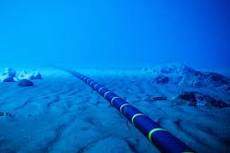This Cable Is Known As :- Submarine Cable


A submarine communications cable is a cable laid on the sea bed between land-based stations to carry telecommunication signals across stretches of ocean and sea. The first submarine communications cables laid beginning in the 1850s carried telegraphy traffic, establishing the first instant telecommunications links between continents, such as the first transatlantic telegraph cable which became operational on 16 August 1858.
Submarine cables first connected all the world's continents (except Antarctica) when Java was connected to Darwin, Northern Territory, Australia, in 1871 in anticipation of the completion of the Australian Overland Telegraph Line in 1872 connecting to Adelaide, South Australia and thence to the rest of Australia.
Subsequent generations of cables carried telephone traffic, then data communications traffic. These early cables used copper wires in their cores, but modern cables use optical fibre technology to carry digital data, which includes telephone, Internet and private data traffic. Modern cables are typically about 25 mm (1 in) in diameter and weigh around 1.4 tonnes per kilometre (2.5 short tons per mile; 2.2 long tons per mile) for the deep-sea sections which comprise the majority of the run, although larger and heavier cables are used for shallow-water sections near shore.
Cable to India, Singapore, East Asia and Australia
Eastern Telegraph Company network in 1901. Dotted lines across the Pacific indicate planned cables laid in 1902–03.
Throughout the 1860s and 1870s, British cable expanded eastward, into the Mediterranean Sea and the Indian Ocean. An 1863 cable to Bombay (now Mumbai), India, provided a crucial link to Saudi Arabia.[16] In 1870, Bombay was linked to London via submarine cable in a combined operation by four cable companies, at the behest of the British Government. In 1872, these four companies were combined to form the mammoth globe-spanning Eastern Telegraph Company, owned by John Pender. A spin-off from Eastern Telegraph Company was a second sister company, the Eastern Extension, China and Australasia Telegraph Company, commonly known simply as "the Extension". In 1872, Australia was linked by cable to Bombay via Singapore and China and in 1876, the cable linked the British Empire from London to New Zealand.
World Map
Construction
Landing of an Italy-USA cable (4,704 nautical miles long), on Rockaway Beach, Queens, New York, January 1925.
Transatlantic cables of the 19th century consisted of an outer layer of iron and later steel wire, wrapping India rubber, wrapping gutta-percha, which surrounded a multi-stranded copper wire at the core. The portions closest to each shore landing had additional protective armour wires. Gutta-percha, a natural polymer similar to rubber, had nearly ideal properties for insulating submarine cables, with the exception of a rather high dielectric constant which made cable capacitance high. William Thomas Henley had developed a machine in 1837 for covering wires with silk or cotton thread that he developed into a wire wrapping capability for submarine cable with a factory in 1857 that became W.T. Henley's Telegraph Works Co., Ltd. The India Rubber, Gutta Percha and Telegraph Works Company, established by the Silver family and giving that name to a section of London, furnished cores to Henley's as well as eventually making and laying finished cable.In 1870 William Hooper established Hooper's Telegraph Works to manufacture his patented vulcanized rubber core, at first to furnish other makers of finished cable, that began to compete with the gutta-percha cores. The company later expanded into complete cable manufacture and cable laying, including the building of the first cable ship specifically designed to lay transatlantic cables.
Gutta-percha and rubber were not replaced as a cable insulation until polyethylene was introduced in the 1930s. Even then, the material was only available to the military and the first submarine cable using it was not laid until 1945 during World War II across the English Channel.In the 1920s, the American military experimented with rubber-insulated cables as an alternative to gutta-percha, since American interests controlled significant supplies of rubber but did not have easy access to gutta-percha manufacturers. The 1926 development by John T. Blake of deproteinized rubber improved the impermeability of cables to water.
Many early cables suffered from attack by sea life. The insulation could be eaten, for instance, by species of Teredo (shipworm) and Xylophaga. Hemp laid between the steel wire armouring gave pests a route to eat their way in. Damaged armouring, which was not uncommon, also provided an entrance. Cases of sharks biting cables and attacks by sawfish have been recorded. In one case in 1873, a whale damaged the Persian Gulf Cable between Karachi and Gwadar. The whale was apparently attempting to use the cable to clean off barnacles at a point where the cable descended over a steep drop. The unfortunate whale got its tail entangled in loops of cable and drowned. The cable repair ship Amber Witch was only able to winch up the cable with difficulty, weighed down as it was with the dead whale's body.
Thank,s For Visiting
















0 Comments